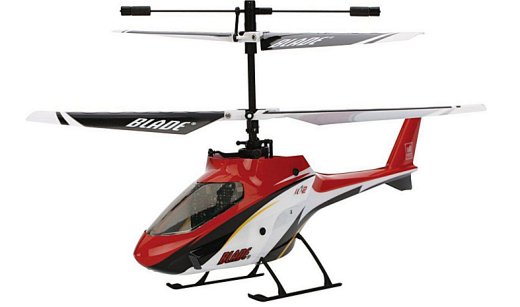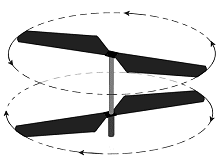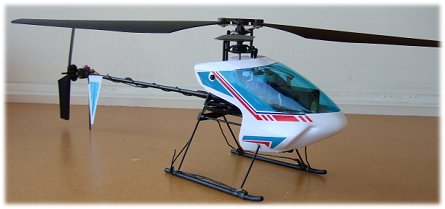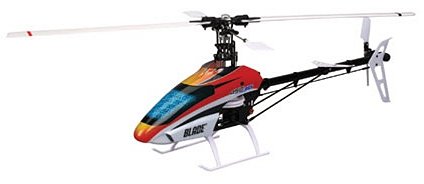*My website, RC Airplane World, is now for sale. Established 20+ years, big potential. Contact me through my contact page if you are interested!*
Electric RC Helicopters
- Coaxial, FP or CP : Which is for You?
Over the years electric rc helicopters have become very affordable, very widely available and much easier to fly than radio controlled helis ever have been, bringing countless new people to the radio control flying hobby.
RC helicopters now make up a very large sector of the hobby and many rc airplane flyers - who once would have only flown planes - have at least one heli in their hanger.
While the popularity, wide availability and affordable prices are all great news for the hobby, it's not so great for the beginner who can quickly find himself or herself completely overwhelmed with which type of electric powered (EP) rc helicopter to buy.
Hopefully this article will break down some barriers and clarify some differences between rc helicopter types...
Essentially there are three categories of electric rc helicopter - coaxial, fixed pitch and collective pitch, the latter two being commonly abbreviated to FP and CP respectively.
Coaxial Electric RC Helicopters

Most electric rc helicopters follow the conventional heli layout with a single main rotor and a tail rotor, but there are also helis that have two main rotors, one above the other, and no tail rotor; these are called coaxial rc helicopters, also sometimes called dual rotor or contra-rotating helicopters.
The Blade mCX2, shown above, is a fine example of a micro coaxial rc helicopter.
Blade electric rc helicopters are manufactured by rc marketing giant Horizon Hobby, and the company was the first to produce a Ready To Fly coaxial heli (the E-flite Blade CX2) to be sold with the (then) new 2.4GHz radio system. It sold in its thousands!
That was well over a decade ago now, but Horizon has since remained at the forefront of hobby-grade electric rc helicopters and their Blade range offers excellent quality at good prices.
 On such a coaxial rc helicopter, the two main rotors spin in opposite directions to one another. As a result, the torque force that's naturally generated by one spinning rotor is cancelled out by the other spinning rotor.
On such a coaxial rc helicopter, the two main rotors spin in opposite directions to one another. As a result, the torque force that's naturally generated by one spinning rotor is cancelled out by the other spinning rotor.
Since it's this torque force that makes a tail rotor essential on a conventional single rotor helicopter, a coaxial rc helicopter doesn't suffer from the same torque effect and so a tail rotor isn't necessary. That's one less channel to worry about when learning to fly!
This type of electric rc helicopter is very stable in the air and can be flown around with little difficulty, even by someone with no prior experience.
Hovering and forward flight is easily achieved but it has to be said that a coaxial helicopter is somewhat limited in its flight performance; banked turns, fast forward flight and aerobatic maneuvers are out of the question.
But for a gentle and easy introduction to multi-channel rc helicopter flying, a coaxial is a good choice and their popularity speaks for itself.
Coaxial electric rc helicopters do have the big advantage of being easy to master and the good 'hobby-grade' ones such as the Blade CX helis can be flown right out the box with little or no setting up involved.
In comparison, a single rotor RTF electric rc helicopter advertised as "Can be flown straight from the box with NO experience!" invariably needs some tweaking here and there, along with some very sensible and time-consuming practice.
Fixed Pitch (FP) Electric RC Helicopters
The next step up from the coaxials is the single rotor fixed pitch helicopter and these, like coaxial helis, have also been very popular with beginners to the hobby.

FP helicopters were big sellers when they first hit the shelves, back in the early 2000s. Helicopters such as the Walkera Dragonfly 4 (shown above), Venom Night Ranger and EF Sabre were all popular in their time, but more recently it seems that this type of heli has died a death. I guess it's thanks to the technological advancements within the hobby - why produce a basic heli when you can produce a better one for the same cost?
There are still FP options out there, of course, and - again - Horizon Hobby's Blade range is a good place to look, with their little 120 SR being a firm favourite.
Fixed pitch electric rc helicopters are in every sense true radio control model helicopters other than they lack collective pitch control to the main rotors.
It's this collective pitch that controls altitude on a real helicopter, by changing the pitch angle of the main blades, but FP helis rely on changes in rotor speed (i.e. main motor speed) to control altitude. Faster turning rotors generate more lift, and vice versa, so motor power is used to make an FP helicopter climb or descend.
The downside to relying on motor power as opposed to collective pitch control is the response time.
The time lag between your throttle stick movement and the change in rotor speed means that maintaining a constant height is at best very tricky, and this is where fixed pitch helicopters let themselves down somewhat. But having said that, they have sold in their thousands and do make an excellent introduction to radio control helicopter flying for those who want more than a coaxial helicopter.
Collective Pitch (CP) Electric RC Helicopters
Succeeding the fixed pitch helicopters in terms of complexity, cost and difficulty-to-master are the collective pitch (CP) helicopters such as the Blade 450 (shown below).
The Blade 450 replaces the very popular Blade 400 and like its predecessor is fully 3D capable. The term '3D' means that the helicopter can perform very advanced and aggressive aerobatics, but this kind of flying takes many many hours (months/years...) of practice and a great deal of confidence!

Above: the Blade 450 is a fairly typical advanced (CP) electric rc helicopter.
And here's the official promo video of this helicopter to demonstrate what such helis are capable of in the right hands...
But even though many CP helicopters like the Blade 450 are marketed as 'Ready To Fly', it is important to remember that they are serious business. Learning the co-ordination of motor power, collective pitch control, cyclic pitch control and yaw takes a lot of time and practice and the process cannot be rushed.
The purchase of an rc flight simulator such as the excellent RealFlight simulator is highly recommended as a serious training aid. It's an extra cost of course, but well worth it if you're even half-serious about the hobby.
Deciding to buy a fully functional collective pitch rc helicopter isn't a decision to make lightly and it's important that you understand what's involved with owning and learning to fly a CP heli.
They're not toys but serious radio control aircraft, and if you're unsure about the seriousness of such helicopters it's best to start off with a simple coaxial or FP model and work your way up to a CP one.
RC HeliHelp Ebooks
You might like to consider buying The Beginner's Guide To Flying RC Helicopters e-book for a complete and comprehensive look at what's involved in getting in to flying rc helicopters. It's a great read and a very small cost to pay for so much essential info.
Another ebook to consider if you're intent on buying a CP helicopter is John Salt's Setup & Tips for Electric Collective Pitch RC Helicopters. An essential resource for anyone looking at getting in to CP helicopter flying, this truly excellent e-book certainly saved me a great deal of time and money when I first started out with a CP electric helicopter!
![]() You can view more of John's brilliant electric rc helicopter e-books right here.
You can view more of John's brilliant electric rc helicopter e-books right here.
An important point: With any single rotor electric rc helicopter of 4 channels or more it's very important to understand that they do have a steep learning curve and should never be classed as a toy; spinning rotor blades can do a lot of damage and all rc helicopters have to be treated with a great deal of respect at all times.
Only coaxial rc helicopters, talked about at the beginning of the page, are much easier to fly with no experience.
Regardless of the type of chopper you choose, the great thing is that electric rc helicopters are now available to the masses and at very affordable prices. And the range is such that there's a helicopter to suit just about every budget, preference and flying need.
The traditional horror stories of how expensive and difficult radio control helicopters are to fly are no longer strictly true. This is excellent news for the hobby, an improvement long overdue!
Related Pages
For my own reasons, I've recently taken down most of my heli pages but here's what is still related on the site:
![]() The Beginner's Guide To Flying RC Helicopters.
The Beginner's Guide To Flying RC Helicopters.
